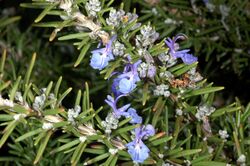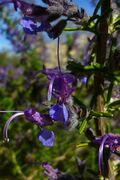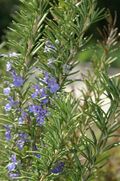Biology:Rosmarinus
| Rosmarinus | |
|---|---|

| |
| Scientific classification | |
| Kingdom: | Plantae |
| Clade: | Tracheophytes |
| Clade: | Angiosperms |
| Clade: | Eudicots |
| Clade: | Asterids |
| Order: | Lamiales |
| Family: | Lamiaceae |
| Tribe: | Mentheae |
| Genus: | Salvia |
| Clade: | Rosmarinus L.[1] |
Rosmarinus (/ˌrɒsməˈraɪnəs/ ROSS-mə-RY-nəs[2]) is a small taxonomic clade of woody, perennial herbs with fragrant evergreen needle-like leaves in the family Lamiaceae, native to the Mediterranean Basin.
In 2017 the species in the genus Rosmarinus were moved into the large genus Salvia based on taxonomic evidence.[3] Thus Rosmarinus is no longer a genus, but still a monophyletic clade of species within Salvia.
Description
Salvia rosmarinus (rosemary), widespread in the Mediterranean region, and Salvia jordanii (formerly Rosmarinus eriocalyx), native to northwest Africa and southern Spain have long been widely recognized. Salvia granatensis (formerly Rosmarinus tomentosus) was first recognized as a separate species in 1941. Rosmarinus palaui was first described as a species in 2002, although recognition of this species remains controversial. Recent research has indicated that while S. granatensis forms a monophyletic group, this group is nested within a paraphyletic S. jordanii.[4]
Salvia jordanii differs from the well-known herb rosemary in its smaller leaves, only 5–15 mm (0.20–0.59 in) long and less than 2 mm (0.079 in) broad, and densely hairy flower stems. It also tends to be lower-growing, often under 25 cm (9.8 in) tall and prostrate, and never exceeding 1 m (3 ft 3 in) tall (S. rosmarinus can reach 1.5 m (4 ft 11 in), exceptionally 2 m (6 ft 7 in), tall).
Rosemary can be propagated from seed or cuttings in summer,[5] and can be spread by carelessly discarding garden waste.[6]
Species
- Species and nothospecies accepted by the Kew World Checklist[7]
| Image | Scientific name | Common name | Distribution |
|---|---|---|---|
 |
Salvia jordanii Jord. & Fourr. | Algerian rosemary | Spain, Morocco, Algeria, Libya |
 |
Salvia rosmarinus L. | Rosemary | Portugal, Spain, France, Italy, Greece, Albania, Bosnia and Herzegovina, Croatia, Montenegro, Morocco, Algeria, Libya, Tunisia, Egypt, Cyprus, Turkey; naturalized in Bulgaria, Crimea, Madeira islands, Canary Islands, Cape Verde, Bermuda, Texas, central Mexico |
| Rosmarinus palaui (O.Bolòs & Molin.) Rivas Mart. & M.J.Costa | |||
 |
Salvia granatensis Hub.-Mor. & Maire | cliff rosemary | southern Spain |
Natural hybrids
References
- ↑ "Genus: Rosmarinus L.". Germplasm Resources Information Network. United States Department of Agriculture. 2004-09-10. http://www.ars-grin.gov/cgi-bin/npgs/html/genus.pl?10549.
- ↑ Sunset Western Garden Book. 1995. pp. 606–607.
- ↑ Drew, Bryan T. (2017). "Salvia united: The greatest good for the greatest number". Taxon 66: 133–145. doi:10.12705/661.7.
- ↑ Rossello, J.A. (2006). "Intragenomic diversity and phylogenetic systematics of wild rosemaries (Rosmarinus officinalis L. s.l., Lamiaceae) assessed by nuclear ribosomal DNA sequences (ITS)". Plant Systematics and Evolution 262 (1–2): 1–12. doi:10.1007/s00606-006-0454-5.
- ↑ Botanica : the illustrated A-Z of over 10,000 garden plants for New Zealand gardens and how to cultivate them. Bryant, Geoff, Burnie, Geoffrey.. North Shore City, N.Z.: David Bateman. 1997. pp. 801. ISBN 1-86953-376-3. OCLC 154295480.
- ↑ "Salvia rosmarinus | New Zealand Plant Conservation Network". http://nzpcn.org.nz/flora_details.aspx?ID=4199.
- ↑ Kew World Checklist of Selected Plant Families
External links
Wikidata ☰ Q1865680 entry
 |


